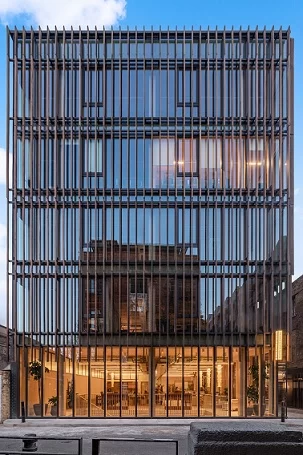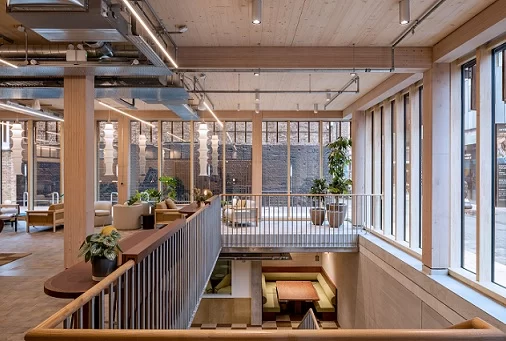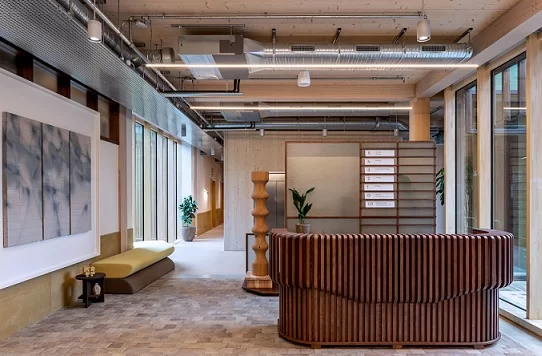
Design-led workspace specialist TOG has come together with dedicated timber specialists Waugh Thistleton Architects to explore a new approach to workplace design. In The Black & White Building, they have explored an ‘architecture of sufficiency’ – where every element serves a purpose, nothing is superfluous, and all materials and processes are as efficient and sustainable as possible.
Their new seven-floor mass-timber building in the heart of Shoreditch sets out to demonstrate that timber is not just a viable alternative to the conventional concrete and steel used to build offices, when it comes to performance and sustainability, it is the preferable option. The tallest mass-timber office building in central London, the tower creates 37% less embodied carbon than comparable structures and is powered by 100% renewable energy sources.
Standing 17.8 meters above the Shoreditch streetscape – on, appropriately enough, the site of a former timber seasoning shed – The Black & White Building is the first building that TOG has actively built from scratch. Best known for sensitive and considered retrofitting and renovation, TOG has worked with Waugh Thistleton Architects to produce a structure that can serve as a model for th office architecture of the future.
A tower of timber
Created using renewable materials and highly innovative construction methods, The Black & White Building is both a landmark in sustainable architecture and a powerful statement of intent for TOG.
The building is situated a stroll from the tech hub of Old Street and Silicon Roundabout, on Rivington Street in Shoreditch – one of London’s very first ultra-low emission thoroughfares.
The previous building on the site – a 11,000 sq ft structure painted black and white – was incapable of meeting the area’s growing workspace demand but also unviable for extension, so TOG co-founders and co-CEOs Olly Olsen and Charlie Green were determined to create the most sustainable building that they possibly could. Their research led them to Waugh Thistleton Architects – a firm responsible for pioneering timber designs for over a decade, including landmark residential blocks such as Dalston Works and Murray Grove, as well as Vitsoe’s Leamington Spa HQ.

“When I heard that TOG were thinking about a new sustainable office building, it’s like I was standing in the queue for a nightclub and they put my favorite song on. I admire the fact they had the commitment and the courage to do this in the first place. They flew in the face of naysayers, and they took the lead. It was very bold of them,” said Andrew Waugh, Waugh Thistleton Architects.
TOG and Waugh Thistleton set out to create a building that minimized carbon in both its construction and, once complete, its operations. The architects proposed a structure built from the ground up using cross-laminated timber (CLT) and laminated veneer lumber (LVL). These highperformance engineered wooden materials generate much less greenhouse gas emissions in the production than steel or cement, saving thousands of tonnes in CO2, while also being highly durable.
Grown in under three hours
“The principal message of The Black & White Building is sustainability – this is a mainstream, gradeA central London office building, built entirely from timber. It clearly demonstrates that mass timber is a viable replacement for concrete and steel in the mainstream office market, saving thousands of tonnes of CO2. We’re trying to change the way we build, to transform the industry,” added Waugh.
As well as generating much less waste than more common building materials such as iron, steel and cement, CLT and LVL also have the advantage of being totally replenishable. The CLT frame was chosen for its perfect balance of sustainability, lightness and strength. Glulam (made from gluelaminated layers of timber) is used for the curtain walling, and the columns and beams are made out of beech LVL.
The structure comprises a combination of timbers from 227 beech and 1,547 pine and spruce trees harvested from certified forests in Austria and Germany. For a sustainable forest to regenerate the quantity of wood used in the construction of The Black & White Building would take approximately 137 minutes – meaning that it’s possible to grow enough timber to construct a six-storey, seven-floor building in less time than it takes to bake a loaf of bread.
CLT is significantly lighter and easier to transport than conventional building materials such as concrete and steel, which means that fewer deliveries are required to bring the necessary quantities to the construction site. This not only represents a carbon-reduction in terms of logistics, it also makes building in dense urban areas a more efficient process that is less disruptive for neighbors and other road users.
Because the timber components are prefabricated, and precision-engineered to be slotted together, the ‘screwed not glued’ building not only requires a smaller workforce to construct, it also has a part to play in the circular economy. At the end of its life, the building can be easily disassembled rather than demolished, and the materials can be recovered and reused. Overall, The Black & White Building creates 37% less embodied carbon than a comparable concrete structure, and serves as a long-term carbon store for 1,014.7 tonnes of CO2 equivalent (55% of the building’s total) sequestered in the timber structure.
“The Black & White Building represents a major step forward for us, and – I hope – the wider industry too. It’s a statement of who we are and how we will approach sustainability; we don’t need to build the traditional way with concrete and steel anymore. We always retrofit when we can, and when we build new buildings in future, TOG is committed to constructing them from timber and other sustainable materials,” said Charlie Green, Co-founder, TOG.

Energy-efficient exterior
The Black & White Building is powered by 100% renewable energy sources – including 80 solar panels on the rooftop. No element of The Black & White Building is purely decorative; everything has a purpose. Notably, the exterior is clad in timber louvres that run from street level to the roof.
These provide natural shade, reducing solar gain on the façade and boosting the natural light reaching the interior. The louvres change in depth as they ascend the building in order to optimize energy- efficiency. The use of louvres also minimizes the amount of solar coating needed to protect the clear glass windows.
The louvres are crafted from thermally modified tulipwood, recommended by the American Hardwood Export Council (AHEC). This timber is highly affordable, lightweight, readily replenished, and has minimal environmental impact. AHEC played a technical advisory role to WTA and recommended the use of thermally modified timber on the exterior of the building. Through extensive research, AHEC has concluded that tulipwood has great strength properties relative to its weight and works well externally after undergoing thermal modification.
“Often high carbon impact materials such as aluminium and glass go on the outside of buildings. However, in this project the louvres are made from wood,” said David Venables, European Director, AHEC. “With thermal modification, you are not using any chemicals. You are taking wood and baking it. Once the timber is dry you put it into an intense heat process. This process enhances the stability and durability of the wood by crystallizing its cambium and protects it from shrinking and swelling.”
Typically, during thermal modification, timber is heated to over 180 degrees Celsius, and the wood’s moisture content is lowered to around 4 – 6%. This stops fungal and insect decay as the baking seals the wood making it less likely to buckle, split or move. During the project, AHEC were able to do some fire testing to prove that TMT tulipwood could be fire treated and provide adequate protection on a multi-storey building. According to Venables, this data wasn’t readily available at the time.
Using TMT tulipwood to envelope a multi-storey building is very much new territory, but given its effectiveness on The Black & white Building, it is likely that similar applications will be seen in both new-builds and retrofits as a means of reducing carbon consumption and solar gain. As an additional benefit, the tulipwood of the louvres appeals to our inherent appreciation for natural materials – something that the building’s interiors by Daytrip, with their exposed timbers and natural textiles, also make the most of.
“It’s good for the soul to be surrounded by natural materials. It’s good for companies because people working in timber buildings tend to stay in the job longer, they feel happier and they’re more productive,” added Waugh.
The thermally modified timber has been manufactured by New Hampshire based Northland Forest Products, who began thermally modifying wood in 2007 with the intention of bringing green decking and cladding products to market to provide an alternative to other increasingly expensive and environmentally challenged species.
“After experimenting with tulipwood as a decking product, we quickly realized that its tall, cylindrical growth and excellent dimensions made it a great species for cladding and other vertical applications. With our second production facility located in Virginia, we also wanted to leverage being close to one of the best tulipwood growing regions,” said Scott Seyler, Vice President, Northland Forest Products.

In The Black & White Building, the external thermally modified tulipwood louvres have a high-quality smooth finish that does not require sanding, treatment, or needs to be serviced. As the building has been built to be demountable, the louvres can be removed and repurposed at the end of the scheme’s life. With this type of timber, you can machine and profile it after you have treated it. This is a huge advantage because you can accurately cut sections of it.
Designed for connection Internally, The Black & White Building has been consciously designed to encourage interaction and collaboration, enabling people to connect through a variety of spaces in multiple ways. Lounges of various sizes and layouts are found throughout, as well as plentiful break-out areas and pockets of outdoor space, culminating in a decked rooftop terrace offering cityscape views, ideal for sunny days.
To maximize natural light in the building throughout the day, a lightwell runs the full height of the building from the rooftop terrace down to a courtyard containing a maple tree on the lower ground floor. Overall, the building is home to 28 offices of various sizes, 6 meeting rooms, focus booths and break-out areas, 94 bike storage spaces and showers.
On the lower-ground floor, beside the indoor courtyard and open to the sunlight, is a dedicated yoga and barre studio – the first in TOG’s portfolio – which will host a timetable of wellness activities focused on holistic health. As well as assorted yoga disciplines and barre, classes will include Pilates, HIIT, breathwork and meditation, with the space freely available to members from across the TOG network in between sessions.
As with the exterior, every feature of the internal space is functional and honest, echoing the emphasis on timber as the structural essence of the building – the environmental credentials clearly written into the materials. The entire building is, as Waugh Thistleton has described it, ‘visibly sustainable’. The sensory impact of the space is significant. “I love that kind of ‘whoosh’ sensation you get when you first come in – the beauty, excitement and aroma. When you walk through the front door and discover the contemporary-cathedral quality to the space, you just feel that there’s a sense of overwhelming optimism about the building,” said Waugh.
A benchmark for building sustainably
For both TOG and Waugh Thistleton Architects, The Black & White Building represents a proof of concept that they hope will inspire and encourage the wider architectural community to adopt carbon-minimal construction methods and engineered timber materials. In the short term, the building will provide a Shoreditch home for creative businesses determined to make a make a credible sustainability statement. In the long term, it is a call to kickstart a new era of architecture, founded on low-carbon construction, circular thinking, and natural materials.
